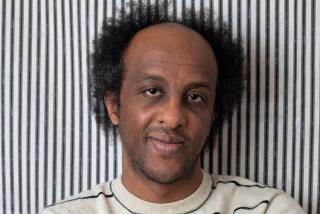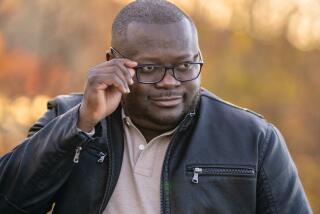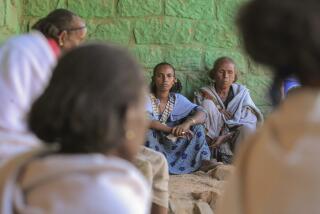A Doctor Fulfills Her Mission: Ethiopia ’85
A week before she penned those words, Dr. Pamela Sutton lay in her tent in the middle of the night, listening to the howls of wild dogs and hyenas. In the distance, men and women wailed, and the gong of the nearby church rang nine times, signaling death in the village. Although sleep wasn’t coming easily, the cool night air was welcome relief from the 104-degree heat of the day.
For Sutton, who spent her formative years amid plenty in Newport Beach, the mournful sounds would become all too familiar. This was Ethiopia 1985--a place and time where people were dying of starvation. As a doctor, she had seen death before, but in this faraway place, death was as predictable as darkness at the end of the day.
From late May until early September of last year, Sutton lent her medical expertise to the Ethiopian effort of Church World Service, an Elkhart, Ind.-based agency that provides relief and refugee assistance and is funded through the National Council of Churches.
At first fearful that her own medical training would be found wanting in such a life-and-death setting, Sutton learned that she could do the work--often ministering to 150 patients a day. More important, she fulfilled a lifelong conviction that she someday would help people in the Third World.
Last week, relaxing in her parents’ Newport Beach home on her 38th birthday, Sutton talked about her summer of ’85. It was an especially reflective week because Sutton was home to attend the 20th reunion of her Corona del Mar High School graduating class.
The African memories are particularly vivid. Every night in Ethiopia, writing by candlelight after a workday that began shortly after dawn, she wrote in a journal. Those memoirs have been published in “Ethiopian Journal,” a $7.95 paperback published by Sherwood-Spencer Publishing Co. of Newport Beach and available at several local book outlets.
Sutton, a petite woman who still walks with a slight limp caused by polio during childhood, said it was a privilege, rather than a sacrifice, to live in such perilous conditions.
She had more than one brush with the wilds and wildlife of Africa. On Aug. 7 she wrote:
Last night I killed a large scorpion that insisted on dancing towards me outside the shower tent. When he shook his stinger at me, I crushed him with a bottle of detergent. Not easy to crush, it was kind of awful.
But the journal goes far beyond a tale of life in the wilds. Rather, it is Sutton’s daily account of both the depth of the famine and the bonds she developed with her ill-fated patients and the staff at the feeding center.
Her four-month stint as the camp’s only doctor was a physical ordeal. She lost 15 of her 105 pounds, suffered from chronic diarrhea and contracted one debilitating cold after another. Saddened by the daily knell of death, she was heartened, too, by the miracle of saving lives.
One of the first patients she had met was a teen-age boy, Ali Mussa, whose small body was wracked by the effects of tuberculosis and a parasitic disease, schistosomiasis. Through her efforts, and those of a visiting television news team, she was able to obtain medicine from the United States to save the boy’s life. She wrote, shortly before her departure:
I spent part of the day in the clinic . . . (Ali Mussa) has been fantastically well, gaining weight and looking better every day.
Her sense of mission had been inside her for more than 25 years. While gazing into a Pacific sunset one night, at about 12 or 13, she was overwhelmed with a vision of her own future. Suddenly, the reading she had been doing about Dr. Albert Schweitzer and Tom Dooley had come alive.
“For lack of anything else to call it, it was a religious experience,” she said. “Something happened to me, and I never forgot it. I felt like I was called, like I was supposed to go, and I felt like I got asked to go.”
The message didn’t come with a precise destination, but she was content to learn and wait, earning her medical degree at the University of California, San Francisco. But by the time she finished her medical residency in Rochester, N.Y., about 15 years later, her medical future was, at best, a fuzzy picture.
Disillusioned by her residency’s high-volume patient load, Sutton wondered how she could realize her dream of reaching out to help.
“I had this vision, which was very adolescent, of Albert Schweitzer holding the hand of a child in the middle of Africa and all this one-on-one personal care,” she said. “Well, that doesn’t square with reality, and by the time I finished my residency I figured that out.”
Unsure of her direction, she went to London in 1977 and studied tropical medicine before returning to the United States to study nutrition at the Massachusetts Institute of Technology. “It was pretty crazy to be 28 or whatever I was at that point, to have all this education and not want to use it. I had to find some way to use it.”
What she found was a fledgling hospice program in the Fort Lauderdale, Fla., area. It was set up in 1978 to help dying patients and their families cope with their plight, and Sutton discovered that she had an aptitude for it. By 1981 she had established her own full-time private hospice practice, which she maintains today.
But those inner voices still weren’t silenced.
“In November of ‘84, I was watching TV and seeing all those poor starving kids, like everybody else in the Western world, and I thought, ‘Maybe this is what I’m supposed to do,’ ” Sutton said. “I had no desire to go to Ethiopia, honestly, but I thought ‘if I’m supposed to do it, I’ll do it.’ ”
The feeding-center sponsors said her duties would be to supervise the nutrition and fluid problems for children in the small village of Geweha (pronounced Jo-ha), half a day’s drive by Land Rover northeast of the nation’s capital of Addis Ababa.
That turned out to be but a minor part of her job. “I knew as soon as I got there, they had a medical clinic which was seeing a huge volume of people that I hadn’t been told about,” Sutton said. “It’s a good thing I wasn’t told because I probably would have been reluctant to go. As it turned out, I adjusted and discovered I could do it.”
Without proper medical books on hand, she relied on her knowledge of tropical diseases to make educated guesses about what she was treating. The most common maladies, she says, were high fever and chills (probably malaria), relapsing fever (a spirochetal disease often carried by lice and ticks), bloody diarrhea (most likely the result of tuberculosis), and extreme bodily fluid loss, which was probably cholera.
She had heard the horror stories from the first day: how earlier in the year, when the clinic opened, people had crawled up the road to the center. Some died on the road. By the time Sutton arrived six months later, the incoming relief shipments had stemmed that death toll.
The center’s task was grimly simple. Every two weeks, mothers would bring in their children from their huts in the surrounding hillsides and have them weighed. If they qualified, they got the supplement. “We fed 17,000 kids every two weeks,” Sutton said. “That didn’t include families. If things didn’t come in on time, the family was hungry. So we had a lot of people in our center, begging for food from us. If they needed more, sometimes they would switch kids or borrow someone else’s kid so they would qualify.”
The supplement was a mix of corn, soy, milk, sugar and vitamins. Mothers carried the supply home in a sack. When mixed with water, it resembled cream of wheat.
And as the weeks passed, Sutton learned a lesson about high-volume medicine. Much to her surprise, she developed personal relationships with the patients, although she saw about 145 to 160 a day. “I got to love a lot of them. Not because I could talk to them because we didn’t speak the same language but because people are people and their eyes tell you a lot. You make eye contact and you touch them--you bond to people even though you can’t talk to them a lot.”
On July 30, she wrote:
Today a 4 -year-old named Negasse died in intensive. He had been anemic and limp for days with a palpable liver and a very alert look in his eyes, even with death around the corner. Yesterday as we examined him, his mother cried. She knew. This morning . . . I saw a body wrapped in a blanket and tied with rope. It could have only been Negasse . . . . One more burial mound in the cemetery. We don’t always know to whom the mound and the wailing belong. This time we knew.
Sutton’s journal began as letters to friends. After they encouraged her to make it something more permanent, she saw greater possibilities for her diary.
“I’d like people to understand those people we saw on TV were real people. They’re like us. The people who are starving are not the (Marxist) government, and people should know the aid got through. I was told recently that enough got through that 7 to 8 million people were saved that would have died.”
Last week, preparing to return to her Pompano Beach, Fla., home, Sutton, who is single, talked of the promise that Ethiopia let her fulfill. “I feel now like I can die,” she said. “I know that sounds melodramatic, but I feel like I accomplished something I had to do.”
One of her last journal entries, dated Sept. 7, read:
Blinded by tears, Mary and I bid goodby to our workers, patients and friends this morning. There was emotion in the eyes of Hedair, our camp guard. Daniel and Hailu were crying, Abdullah sad. Mothers of children in intensive kissed me multiple times and began to wail. Ali Mussa was sobbing at the door of our Land Rover and poor little Hassan was bewildered. I tried to get him to repeat “I love you” as he has before, but he was unable . . . .”
More to Read
Sign up for Essential California
The most important California stories and recommendations in your inbox every morning.
You may occasionally receive promotional content from the Los Angeles Times.










